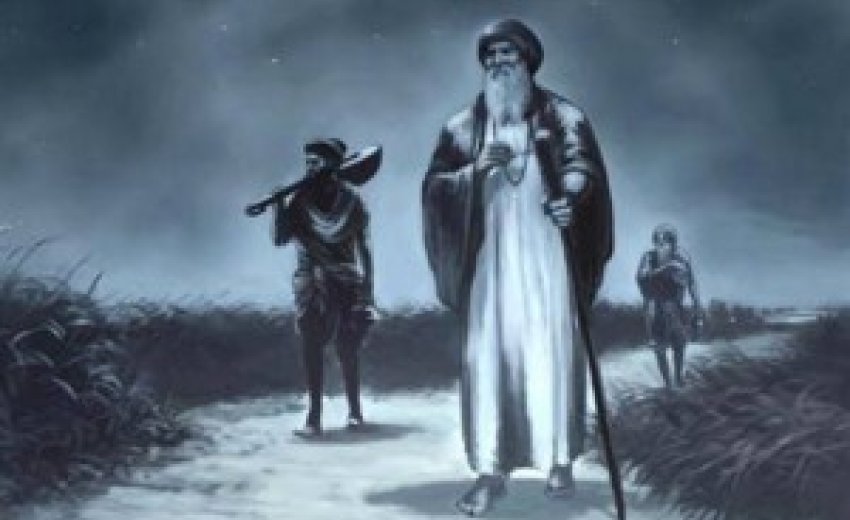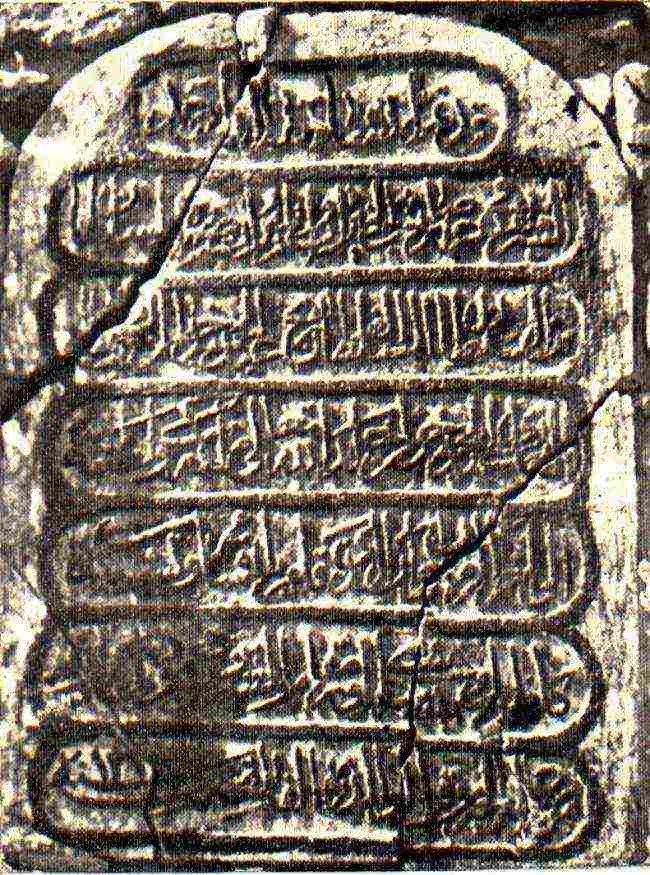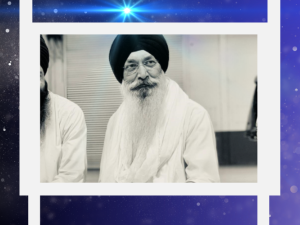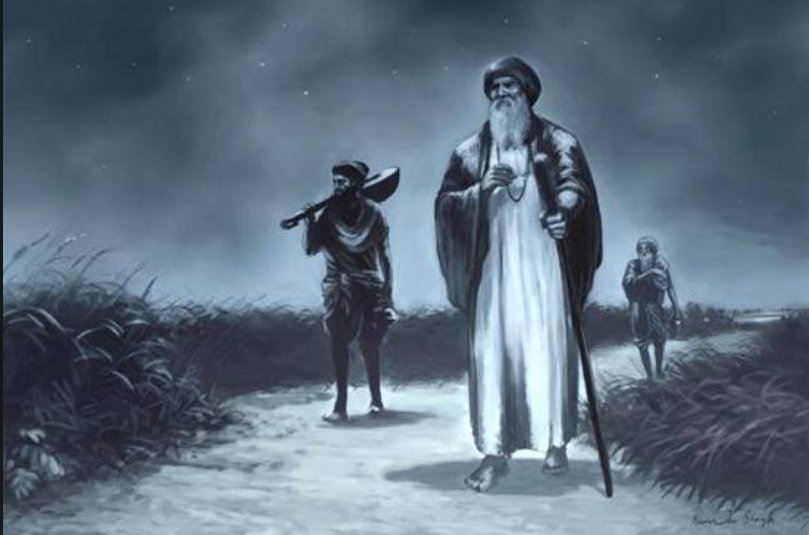
Did Guru Nanak visit Saudi Arab and Iraq in First itinerary?
An Enquiry
Shri Ananda Acharya in his published work 'Snow Birds', Macmillan and Co., 1919 has a published poem, "On Reading an Arabic Inscription in a Shrine Outside the Town of Baghdad dated 912 Hijira," [1] as reproduced hereunder:
- Upon this simple slab of granite didst thou sit, discoursing of fraternal love and holy light, O Guru Nanak, Prince among India's holy sons!
What song from the source of the Seven waters thou didst sing to charm the soul of Iran!
What peace from Himalayas' lonely caves and forests thou didst carry to the vine-groves and rose-gardens of Baghdad! - What light from Badrinath's snowy peak thou didst bear to illumine the heart of Bahlol, thy saintly Persian disciple!
Eight fortnights Bahlol harkened to thy words on Life and Path and Spring Eternal, while the moon waxed and waned in the pomegranate grove beside the grassy desert of the dead.
And after thou hadst left him to return to thy beloved Bharta's land, the faqir, it is, said, would speak to none nor listen to the voice of man or angel;
His fame spread far and wide and the Shah came to pay him homage-but the holy man would take no earthly treasures nor hear the praise of kings and courtiers.
Thus lived he-lonely, devoted, thoughtful- for sixty winters, sitting before the stone whereon thy sacred feet had rested; - And ere he left this house of ignorance he wrote these words upon the stone: "here he spake the Hindu Guru Nanak to fakir Bahlol, and for these sixty winters, since the Guru left Iran, the soul of Bahol has rested in the Master's word-like a bee poised on a dawn-lit honey-rose."[1]
During the First World War when British and Indian armies conquered Baghdad, Sikhs discovered the place where Guru Nanak had his discourse with Bahlol. It lies to the west of the town, between the old graveyard to the north and the present Baghdad-Samara railway line to the south. Dr. Kirpal Singh, then a Captain in the Indian Medical Service, also saw it during the War, and he, in his letter to his brother, dated October 15, 1918, described it as follows:
"It is really a humble looking building and known to very few people except Sikhs. To some Arabs it is known as well by the name of 'tomb of Bahlol'. You enter the building by a small door, on which something is written in Arabic, not visible to a casual visitor. Even with attention it is difficult to read. I could not read it hence could not copy it. I have taken the photograph of the outside, which I shall forward to you in due course. Entering the building, you come to a brick paved passage going to your right straight into the room (with a verandah), wherein you find the tomb and the raised platform. In the courtyard there are a few trees, mostly pomegranates."[2]Words upon the stone 'the Arabic inscription', is as given below:
From the above poem following comes to the fore:
- Existence of an inscription dated 912 Hijri (1506 A.D.) in Baghdad, depicting Guru Nanak's visit to the place.
- Baghdad was a part of Iran then?
- Bahlol, a Persian saintly disciple listened to the Guru's discourses/words on Life and Path and Spring Eternal for eight fortnights (8x15=120 days i.e., 4 months)
- Bahlol lived for 60 years thereafter well venerated by the public and the King.
- Bahlol got inscribed on the stone, "Here he spake the Hindu Guru Nanak to fakir Bahlol, and for these sixty winters, since the Guru left Iran, the soul of Bahlol has rested in the Master's word-like a bee poised on a dawn-lit honey-rose."
- Is the date of visit of Guru Nanak to Baghdad as 912 Hijri (1506 A.D.) correct?
- Did Guru Nanak stay at Baghdad for 4 months?
- Who was Bahlol? What was his relationship with Guru Nanak?
- Did Bahlol got a building constructed commemorating Guru Nanak's visit.
- Did Bahlol lived upto 1506+60 years=1566 AD?
On the wall of the monument there is another script as shown below:
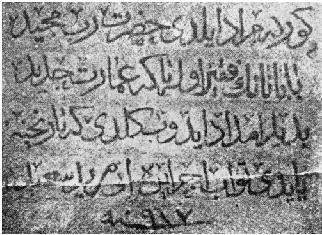
Dr Chahal [3] got the translation of the above from Dr Mehmedoglus as under:
'Allah the Almighty willed that this monument or building of humble Baba Nanak will be a new benevolent foundation for dissemination of wisdom. Seven saints came to help to erect this building on Hijri 917'.
Hijri 917 is equivalent to 1511 CE according to the Date Conversion System [3]. This has also been confirmed by Dr Ali Ulvi Mehmedoglu from the writings at the end of the inscription. It means that this inscription was inscribed either during the time of Guru Nanak's stay or after that when he left Baghdad. Dr Chahal further mentions that the date Hijri 917 (1511 CE) in that inscription (Fig. 1) is a proof strong enough to show that Guru Nanak was in Baghdad before or around that year (1511 CE). However, from the translation it can be established only that the building commemorating the visit was constructed in Hijri 917 (1511 CE) and not that Guru Nanak was in Baghdad in 1511 CE. It however proves that Guru Nanak visited Guru Nanak in 1511 CE and not later since monument could be erected only after the occurrence of event.
In his paper Prof Himmat Singh [4] mentions of three recently located manuscripts 'Syahto Baba Nanak Faqir' (1509 AD) (5) written by Taj-u-deen Naqshbandi, Twareekh-i-Arab'(1505-06 AD) (6) written by Khwaja Zain ul Abideen and Gunitusalehin (1506-07) written by Abdul Rahman.(7)
Writer of 'Syahto Baba Nanak Faqir' (1509 AD) manuscript [5] travelled along with the Guru from in 1504-06 CE and wrote the daily accounts of his travels to Mecca-Medina and wrote the manuscript in 1509 CE and kept it safe in Medina library.
Khwaja Zain-ul-aab(i) Deen the writer of Twareekh(i) Arab, (1505-06 AD, unpublished) [6] was present in Qabristan of Mecca in the presence of Guru Nanak. He wrote in the chapter Bab-ul-Mecca of his book 'Twareekh-i-Arab' (p. 300): The sermon of Guru Nanak was heard by 300 followers. Ruqun-ud-Deen went into deep meditation. Thereafter Ruqun-ud-Deen never went back to his home and remained in meditation in a cave till he was put to death by the fundamentalist regime.
When Amir of Mecca came to know that the Muslims are following an infidel, he issued fatwas. These fatwas (religious orders) were;
- Nanak faqir is an infidel. His teachings are falsehood and against the Muslim religion.
- Ruqun-ud-Deen's entire property will be confiscated.
- The Khwesh tribe, the follower of Guru Nanak is ordered to leave the country.
- Each followers of Guru Nanak 'to undergo beating by 30 lashes and to be without food for 11 days.'
- They will then be buried in sand dunes.
- Before this they will be taken on camels around the city with blackened faces.
- They will be hung upside down.
- The strongest follower of Guru Nanak (Ruqun-ud-deen) will be buried in ground till his chest and then stoned to death.
Amir of Mecca sent his men to locate and eliminate Guru Nanak as well. Abdul Rahman the writer of another book Gunitusalehin (1506-07) [7] was one such person assigned the job. He wrote about his encounter with Guru Nanak in his book: "When I was driving my horse with speed and hurry; my horse stopped abruptly. I tried to move him by kicking and hitting but the horse did not move. I lifted my head to find in front that at a distance of 100 yards the faqirs were seated. The elderly person in the midst of them had a brightened face and an aura around of him more powerful than thousands of suns. This brightness shut my eyes and I had a revelation that I was about to commit a crime. The horse proved better than me who saved me from committing this crime even though I gave him lashes to advance. In front of me is the same Godly person who had moved Mecca mosque. Shah Sharaf and Ruqun-ud-Deen became his devout followers. He has rightly spread the True Name of God among the Arabs and is now in front of me. I regained my senses and thought of doing the right. I immediately saw the reason; left my horse and shoes and fell at his feet."
The above three evidences given in the manuscripts quoted that Guru Nanak was in Saudi-Arabia and Iraq between 1504 to1507 CE. This matches the evidence given in the two stone inscriptions and the date mentioned by Ananda Acharya.
His meeting with Bahlol however needs a separate study since the existing sources mentions of Bahlol to be of the period well before Guru Nanak. It is most probable that this Bahlol may be a Gaddi Nadshin since even Gaddi Nashins and followers were also called their names after their asters as we find Shiekh Ibrahim called as Sheikh Wazeed. Followers of Gorakh, Machhinder, Bhartari Hari etc., too have been called by these names as well. [3]
If Guru Nanak travel Arab between 1504-1507 CE, then how can it be the Third itinerary? Janam Sakhi Bhai Bala (ed by Dr Kirpal Singh, Antika p. 280), mentions of Guru Nanak proceeding to Mecca from the East Asia after meeting King Kawalnain. 'Mardana asked the Guru, "Where is the place called Makka?" Guru Nanak replied, "Mardana! Do you want to see it?" Mardana said, "Turks praise it a lot. Let us see this as well." ……Guru Nanak said, "It is 2500 kos (4000 Miles from here. Hindus are not allowed there." (p. 280)
If we look at these distances between Bangkok in East Asia to Makka it is 4018 miles. 2500 kos as mentioned by Guru Nanak is equal to 4000 miles. If we take say distance from another city e.g., Lahore to Makka the distance is 2240 miles which does not tally. Hence the distance travelled from East to Makka is more logical than the one from Lahore or Punjab. Hence the travel to Makka from East distance wise in first itinerary itself appears logical.
From the above it can be concluded that:
- Guru Nanak travelled to Arab Countries between 1504-1507 CE.
- Guru Nanak is most likely to have visited Arab countries in first itinerary itself after his visit to East Asia.
- Since no other reliable dates of Guru Nanak's travels are available except of his being at Sayyadpur in 1521 A.D. acceptance of these dates will also have to be done with caution and with detailed research as it changes the very face of four or five itineraries as mentioned in Puratan Janamsakhi and other sources/books published later.
References
[1] Reproduced from Dr Ganda Singh edited The Punjab Past and Present, Vol III,1969, p. 344.
[2] SikhiWiki, Guru Nanak in Baghdad.
[3] Devinder Singh Chahal, Dr. 2010, Did Guru Nanak Meet Pir Dastgir and Pir Bahlol Dana? Understanding Sikhism -Research Journal, January - December 2010, Vol. 12, No 1-2 page 49-51
[4] Himmat Singh (Prof) (2011), Guru Nanak Viaktitav: Ati parmaneek punravlokan, (Tatkaleen Arbi-Farsi srotan anusaar), paper published in seminar proceedings: Guru Kaal de Sarotan vich Guru Nanak Sahib: Jiwan te Shakhshiat, 22-23 November, 2011, Guru Nanak Dev University, Amritsar, pp. 135-140
[5] Taj-u-deen Naqshbandi (1509 AD, unpublished) Syahto Baba Nanak Faqir, original in Mecca State Library, translated into Punjabi by Sayyad Prithipal Singh in 1927-30, presently with Prof Himmat Singh (Reference 4)
[6] Khwaja Zain ul Abideen (1505-06 AD, unpublished) Twareekh-i-Arab, translated by Mohammed Iqbal, manuscript presently with Prof Himmat Singh (Reference 4)
[7] Abdul Rahman (1506-07), Gunitusalehin, manuscript presently with Prof Himmat Singh (Reference 4)
